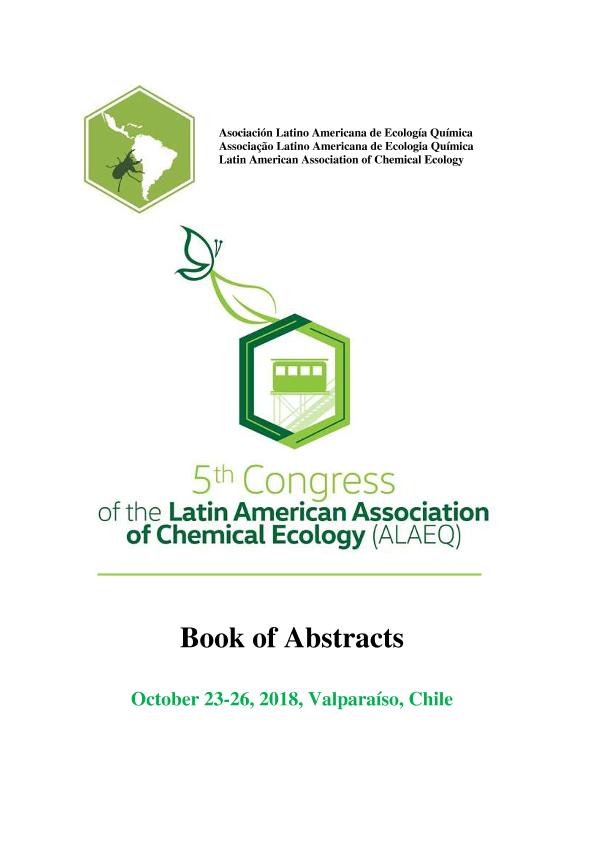Mostrar el registro sencillo del ítem
dc.contributor.author
Manzano, Carolina

dc.contributor.author
Coll Araoz, Maria Victoria

dc.contributor.author
Luft Albarracin, Erica Beatriz

dc.contributor.author
Fernandez, Patricia Carina

dc.date.available
2023-02-10T17:25:56Z
dc.date.issued
2018
dc.identifier.citation
Attacked Citrus Plants Release Synomones that Attract an Egg Parasitoid, Cosmocomoidea annulicornis (Hymenoptera: Mymaridae); 5th Congress of the Latin American Association of Chemical Ecology; Valparaíso; Chile; 2018; 1-2
dc.identifier.uri
http://hdl.handle.net/11336/187662
dc.description.abstract
It is known that hymenopteran parasitoids generally use a combination of host kairomones and plant induced synomones to locate their hosts. Cosmocomoidea annulicornis (Hymenoptera: Mymaridae) is an egg parasitoid frequently found attacking eggs masses of Tapajosa rubromarginata (Hemiptera: Cicadellidae), a xylem-feeding sharpshooter vector of Xylella fastidiosa, the bacteria that causes Variegated Citrus Chlorosis. In the present study, we evaluated the volatile attraction capacity of citrus plants induced solely by feeding damage of T. rubromarginata, without egg masses, to investigate whether plant volatiles alone could act as cues for host finding. Newly emerged G. annulicornis (< 12 h), naïve females were used for behavioral assays with Y tube olfactometer dual choice tests (n=40). For the induced treatment, Citrus plants (2 years plants, Citrus aurantium var. 75AB, a variety used for grafting lemon trees) were kept in voile fabric bags along with 15 males of T. rubromarginata (to avoid oviposition of females) for 24 h before measurements. Non-induced treatment consisted of healthy citrus plants. Females were offered: (a) Air (control) versus Non-induced plants and (b) Non-induced plants versus Induced plants. Wasps had no preferences between the choices offered in the first experiment (a) (p>0.05), however, when wasps were offered Non-induced plants versus Induced plants, 67.5% parasitoids chose plants attacked by T. rubromarginata. Plant volatiles were isolated and analyzed according to the procedure described by Braccini et al (2015). Non-induced plants produced almost exclusively limonene, whereas induced plants produced a more complex monoterpene mixture. Based on these results, T. rubromarginata feeding damage induces plant synomones, that would be important in C. annulicornis host searching behavior.
dc.format
application/pdf
dc.language.iso
eng
dc.publisher
Pontificia Universidad Católica de Valparaíso
dc.rights
info:eu-repo/semantics/openAccess
dc.rights.uri
https://creativecommons.org/licenses/by-nc-sa/2.5/ar/
dc.subject
SEMIOCHEMICALS
dc.subject
EGG PARASITOID
dc.subject
CITRUS
dc.subject.classification
Zoología, Ornitología, Entomología, Etología

dc.subject.classification
Ciencias Biológicas

dc.subject.classification
CIENCIAS NATURALES Y EXACTAS

dc.title
Attacked Citrus Plants Release Synomones that Attract an Egg Parasitoid, Cosmocomoidea annulicornis (Hymenoptera: Mymaridae)
dc.type
info:eu-repo/semantics/publishedVersion
dc.type
info:eu-repo/semantics/conferenceObject
dc.type
info:ar-repo/semantics/documento de conferencia
dc.date.updated
2023-02-09T13:37:03Z
dc.journal.pagination
1-2
dc.journal.pais
Chile

dc.journal.ciudad
Valparaíso
dc.description.fil
Fil: Manzano, Carolina. Consejo Nacional de Investigaciones Científicas y Técnicas. Centro Científico Tecnológico Conicet - Tucumán. Planta Piloto de Procesos Industriales Microbiológicos; Argentina
dc.description.fil
Fil: Coll Araoz, Maria Victoria. Consejo Nacional de Investigaciones Científicas y Técnicas. Centro Científico Tecnológico Conicet - Tucumán. Planta Piloto de Procesos Industriales Microbiológicos; Argentina
dc.description.fil
Fil: Luft Albarracin, Erica Beatriz. Consejo Nacional de Investigaciones Científicas y Técnicas. Centro Científico Tecnológico Conicet - Tucumán. Planta Piloto de Procesos Industriales Microbiológicos; Argentina
dc.description.fil
Fil: Fernandez, Patricia Carina. Universidad de Buenos Aires. Facultad de Agronomía; Argentina. Instituto Nacional de Tecnología Agropecuaria. Centro Regional Buenos Aires Norte. Estación Experimental Agropecuaria Delta del Paraná; Argentina. Consejo Nacional de Investigaciones Científicas y Técnicas; Argentina
dc.relation.alternativeid
info:eu-repo/semantics/altIdentifier/url/http://www.alaeq.org/wp-content/uploads/2018/11/Book-of-Abstract-ALAEQ-2018-FINAL.pdf
dc.conicet.rol
Autor

dc.conicet.rol
Autor

dc.conicet.rol
Autor

dc.conicet.rol
Autor

dc.coverage
Internacional
dc.type.subtype
Congreso
dc.description.nombreEvento
5th Congress of the Latin American Association of Chemical Ecology
dc.date.evento
2018-10-23
dc.description.ciudadEvento
Valparaíso
dc.description.paisEvento
Chile

dc.type.publicacion
Book
dc.description.institucionOrganizadora
Asociación Latinoamericana de Ecología Química
dc.source.libro
Book of Abstracts: 5th Congress of the Latin American Association of Chemical Ecology
dc.date.eventoHasta
2018-10-26
dc.type
Congreso
Archivos asociados
